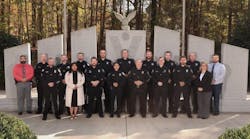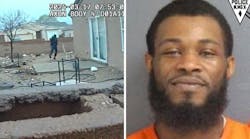Task forces are nothing new to criminal justice. They've existed on every level of law enforcement and academics for decades, and have been used to pursue criminal cases ranging from organized crime to serial killers.
Formed as a coalition of differing perspectives, task forces focus manpower and resources on a common goal. Sometimes, the results are measured in convictions. Other times, results can better be tallied in take-away knowledge.
And almost always there's something to be learned from the combined efforts, even if the outcome is unexpected or doesn't come up with the anticipated answers.
Street gangs and interventions: One case study
With street gangs spreading from urban areas to Middle America, everyone's looking for lasting solutions. Fighting gang-related crime with traditional methods is a lot like putting out a forest fire with a measuring cup — something's being done, but in the long run it's a futile gesture. And to make it even worse, fighting the spread of gangs and their violence doesn't play well with a one-size-fits-all solution. The devil is in the differences.
Since each gang operates autonomously few prevention and intervention techniques have worked across the board. It's understandable the law enforcement community seeks solutions, while academics and social scientists want to study the process.
One important gang task force-related study took place at Rutgers University in connection with a partnership between Rutgers, the Newark (New Jersey) Police Department and several other agencies.
A study of the process, conducted by Dr. Jean McGloin (now at the University of Maryland) in conjunction with the U.S. Department of Justice, Office of Community Policing, took an in-depth look at the Greater Newark Safer Cities Initiative (GNSCI) and the task force that later grew from it.
In her study, McGloin points to other research that has identified certain characteristics of gangs, their adherents and the ultimate effects they have on individuals who live around them. One finding includes that gang membership evolves over time and, as an individual becomes more immersed in the gang, a corresponding rise in his criminal culpability occurs.
Where gangs are concerned, McGloin notes, appropriate problem analysis is key to effective deterrent/enforcement action. She says failure to analyze the problem when adopting a strategy "may result in a futile, even harmful, response plan. For example, one approach in Nevada relied on the incorrect notion that local gangs were similar to those in Los Angeles. It is no surprise, therefore, that it was ineffective."
Once past the group's reportedly fractious history, McGloin says participants worked together to manage the "most at-risk people with the goal of reducing their violent behavior and, in truth, the overall violence in Newark."
The study's findings
In 2003, the gang problem evolved into an even larger concern to law enforcement engaged in the GNSCI. Homicides in Newark were on the upswing and law enforcement officers believed gangs were at the root of the issue.
The GNSCI decided to use its own framework to study the up-tick in violent crime and concluded that since perceived gang issues overflowed its borders into other towns, they would form a new organization within the GNCSI to cover all interests. Thus, the New Jersey Gang Task Force (NJGTF) was born.
Using the Boston Gun Project as a model, the NJGTF soon faced several problems. One major stumbling block was the lack of uniformity of the gang intelligence amassed by different agencies. McGloin characterized the problem as three-fold: (a) the university researchers compiling the database for the project did not have ready access to the intelligence, (b) participating agencies not only used different approaches to recording the information, but the differences made it difficult to integrate the data and (c) old data was rarely purged or updated. McGloin notes the reluctance of law enforcement to share information and documented the progress of the project from the researchers' vantage point.
She says the "first analysis phase included GIS mapping." At the project's conception, it was believed gang activity, when mapped, would reveal what was termed as "hot spots" of activity. However, as it turned out, the opposite was true. In McGloin's words, "Gangs seemed to be everywhere." But even more interesting was the ensuing network analysis.
McGloin defines network analysis as "a technique that focuses on analyzing the pattern of social relationships among groups or individuals." Gathering intelligence and using it to track street gang members and their associates proved an enormous task, mainly due to the size and complicated relationship patterns gangs adopt.
Although the project hoped to identify patterns in street gang orientation, the task force and ensuing study ultimately determined exactly the opposite: the gangs studied were not organized in the type of recognizable hierarchy that characterizes some other criminal organizations such as the Mafia or Asian-based Triad gangs. As a result, the study concluded "collective accountability as a general tactic for gangs in Newark was unlikely to be a successful (sic) in this jurisdiction." That lack of organization makes it more difficult to track, predict and prosecute criminal behavior in street gangs.
In hindsight
Michael Wagers, executive director of the Police Institute at Rutgers-Newark, puts it all in perspective. He says McGloin's study was merely one component of the project and that the task force she referenced in her report never moved beyond the analysis in terms of putting the results into practice However, Wagers says, the intelligence gathered by the task force has been useful when applied to other initiatives.
"Gangs themselves are very disorganized, and again that's what research has shown time and time again," Wagers says the project found. "They don't have the structure that everyone is looking for — that elusive structure, for the most part."
This is critical to both enforcement and prosecution strategy and, of course, a disappointment to officers hoping to apply the strong RICO (Racketeer Influenced and Corrupt Organizations Act) statutes to gang activity and allow gang leadership to be curtailed with carefully controlled removal of those calling the shots.
The study tended to show the observed gang members in north New Jersey hung around with other gang members as a result of geography, past history and interests, rather than hierarchy within the gang itself.
"But there was no real loyalty to each other and you couldn't identify the real leadership of the gangs," Wagers says. "What you could identify, though — and this is where the process broke down in terms of getting our law enforcement partners to use the information — were cut points (McGloin's definition: people who are the only connection among people or groups of people) between gang members or different groups of gang members, which we thought was important." Wagers says that by taking action against the cut point, it further disrupts the group as a whole.
New Jersey, like most states, went from saying "we don't have a gang problem," to recognizing there is one and it's serious, Wagers notes. "We were hoping with the analysis we could continue to really dig deep, dissect what was going on and help inform law enforcement across the state."
Although the study and its general effects have not had the initial hoped-for impact, Wager says it's helped in laying the foundation for implementing other programs by providing intelligence information that can be applied to future enforcement approaches.
Still, Wagers says, it's important to keep in mind that things change — gangs that are disorganized and without form today may be better structured in the future. "This was just a snapshot," Wagers says.
The take-away
Scott Decker, chairman of the Criminal Justice Department at the University of Arizona, says the Newark experience is pretty consistent in gang literature. "The public image is that gangs are highly structured, very well-organized," Decker says. "The more one looks at gangs on the street and talks to gang members, the less one sees that."
Decker says the disconnect is largely a product of the different points from which one taps in to learn about gangs and their issues. He gives the example of information emanating from federal agencies and the U.S., Attorney's office. "What they see are the most highly structured, organized gangs because that's what they prosecute with RICO statutes," he says.
News about gangs based in Chicago or Los Angeles dominates the public perception in many ways, says Decker, from their perception of what gangs do, how well organized they are and the definition of a gang itself. But in reality, diversity persists among gangs across the country. These gangs stray from the Chicago and Los Angeles models in their organization and, Decker notes, law enforcement has reported gangs to be less configured around the gang and more about the profits their illegal activities bring in.
Viewpoints differ greatly between local street officers and federal gang experts, he adds. Many times they see different levels of organization. He attributes the divergent perspectives to the types of crimes with which the two groups come into contact. Local law enforcement answers calls with local impact: property damage, assaults and shootings. Meanwhile, he says, federal law enforcement, including prosecution, tends to become engaged "at the very highest level of crime, at the level at which crime — if it is organized — is likely to be the most organized."
Decker says few gangs are really systemized and explains it this way, "When you think nationally, if the average age of a member is 17, 17-year-olds are not particularly well-organized." For average 17-year-olds — high school juniors and seniors — staying on top of studies, part-time jobs and obligations at home provides a challenge. For gang members, most of whom have little education and are predisposed to violent solutions, a sophisticated hierarchy simply isn't possible.
Decker says the problem of prosecution is actually exacerbated by the lack of organization among most street gangs because, despite excellent RICO statutes and organized crime models, RICO statutes can't be used on gangs "because they can't qualify on the elements."
And he points out what studies like McGloin's can accomplish. "A lot of what we learn from problem-solving efforts, scanning, analysis, etc., has to do with what we shouldn't do, and what we shouldn't do is treat all gangs the same because they're not monolithic," he says. "We shouldn't take a vision or perception of what gangs are like and blithely apply it to gangs in a different jurisdiction."
Wrapping it up
Using a combined response as well as partnering with other agencies and universities to both set that response in motion and study its effects are time-honored approaches to criminal justice issues. But can an approach still be considered a success if it proves just the opposite of what it hoped to find?
Absolutely. In fact, experiments that surprise law enforcement and criminologists often prove even more valuable as investigative tools. By attacking the problem from the standpoint of what is assumed and disproving that assumption, agencies can use the information to generate a more appropriate approach.
In the case of the Newark study, the results concur with other street gang research showing the gang model isn't a good fit with RICO. Although that sends law enforcement and prosecutors back to the drawing board, it also gives them a base from which to work.
The goal, after all, isn't to prove or disprove a theory — it's to find ways to define the job that has to be done. And that's where the Newark gang project and similar undertakings can claim success.


